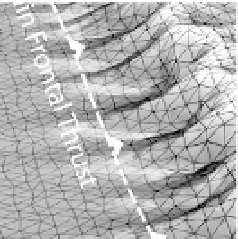Geology Reference
In-Depth Information
Numerical modeling
of landscape evolution
11
We have demonstrated throughout this topic
that the processes involved in generating
landscapes - both those geophysical processes
that generate rock uplift and those surface
processes that attack and rearrange the rock -
are complex in both time and space. The
processes interact with one another to generate
interesting and complicated feedbacks in the
system. Within the last two decades, Earth
scientists have increasingly turned to the use of
numerical models as a means of exploring the
richness of these linkages. As computers have
increased in both speed and memory size, these
models have become more capable of treating
the real-world complexity by discretizing space
and time into smaller and smaller bites. These
models have allowed scientists to understand in
a quantitative sense the linkages among the
processes. They have provided a set of visual
images of how a mountain range or hillslope or
channel ought to evolve under a prescribed set
of rules. They have forced us to document
process rates in the landscape that must be
embedded in the models, and to face difficult
questions such as: “How did a particular
landscape begin?” Finally, and perhaps most
importantly, by embedding our knowledge of
surface and tectonic processes in a logical (rigid,
unforgiving) framework, these models allow us
to investigate where our understanding of these
processes is flawed or weak, toward which new
research efforts should be focused.
In this chapter, we explore the elements of
such models and provide examples from models
that are designed to operate at different time
and length scales. Some, for instance, are
designed to illustrate or mimic the evolution of
individual fault scarps, whereas others are
aimed at mountain range or even orogen scales.
Each will, therefore, require a different set of
assumptions that make the problem tractable,
given the computer resources at the time the
model was generated. In all cases, the goals of
such modeling exercises are to enhance our
ability to derive insights into the operation of
the many processes that conspire to generate
tectonic landscapes.
We have seen throughout this topic that a
landscape owes its shape to the combination of
tectonic and climatic forces. Rock is moved with
respect to the geoid, either upward or down-
ward, by tectonic processes, some of which
result in smooth displacement (creep), and
others in discrete displacement (seismic). This
displacement of rock changes the local elevation
of the Earth's surface. Such displacement affects
geomorphic rates to the extent that geomorphic
processes are altitude dependent, directly in
some instances (e.g., the dominant process
switches to glacial erosion for elevations above
the snowline) and indirectly in others (e.g., as
streams seek a base level, most often sea level,
that is independent of the local rock mass).
In addition, gradients in the vertical deformation































